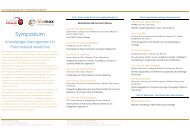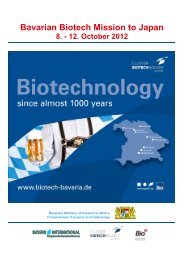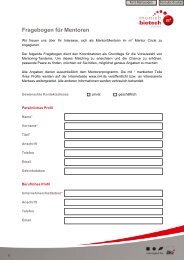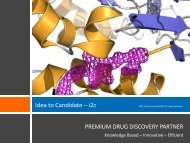Bavarian Biotech Report 2011/2012 (7MB) - Bio M
Bavarian Biotech Report 2011/2012 (7MB) - Bio M
Bavarian Biotech Report 2011/2012 (7MB) - Bio M
Create successful ePaper yourself
Turn your PDF publications into a flip-book with our unique Google optimized e-Paper software.
Last but not least, the IZB start-up centres were especiallydesigned to satisfy the requirements of the biotechindustry with its branches in the north of Munich (Freising-Weihenstephan)and especially Martinsried-Planeggat the southern city limits of Munich. Together they offerfacilities with more than 25,000 m 2 of laboratory andoffice space that currently house more than 50 tenantsand almost 700 employees. Although it was designed fora modest 800 m 2 when the first foundation stone waslaid in 1995, the location between the GrosshadernCampus Hospital of the LMU and the Max Planck Institutesfor <strong>Bio</strong>chemistry and Neurobiology – and mostrecently also the Faculty of <strong>Bio</strong>logy, as well as Chemistryand Pharmacy, and the Gene Centre of the LMU – hasturned out to be perfect. The building expansions werejust capable of keeping pace with the companies'expansion requests or – as was the case of the Proteros<strong>Bio</strong>structures company – were satisfied by a privatelyconstructed laboratory building in close proximity in<strong>2011</strong>. In turn, this enabled the recruitment of additionalcompanies.When a start-up centre exceeds a certain size and complexitywith all of its local and regional networks inpolitics and administration, it is advisable to establish anadditional management organisation that focuses ontechnology and product development. This parallelismexisted in Martinsried and the Greater Munich area fromthe very beginning: <strong>Bio</strong> M was already established in 1997as an institution with its own funding; its purpose wasand still is to help entrepreneurs – in good times and inbad – with advice and support in an industry that wasstill in its infancy. More than 150 company start-ups havebeen assisted since then. This is a quite respectable trackrecord in view of the approximately 130 companiesexisting today.best fruit or have already secured a portion of it. Butwhat does the future look like as more “real” productsare generated in the pharmaceutical sector, whichhopefully means an increasing number of approvedbiotech products from the <strong>Bavarian</strong> pipeline?The German healthcare system as such will ultimatelypose a great challenge. There is much uncertainty as towhether a system dating from the time of Bismarck cancope with the societal challenges of the present and thefuture. The <strong>Bavarian</strong> companies would certainly love toannounce positive news about FDA or EMA approvals inthe near future. However, an oath and a decision as towhether a medicine is successful or not is primarilydependent upon its reimbursability – and this might noteven be attained for quite a while after the approval.<strong>Bavarian</strong> companies have already shown many timesover that they are capable of bringing innovative drugsto market based on their scientific foundation and technologicalexpertise. TRION Pharma from Munich demonstratedthis with Removab in 2009, the first tri-functionalantibody that was invented, developed and brought toapproval on location in Germany by a biotech company.However, they also discovered that reimbursability is amajor issue once this process has been completed.As patients realise the necessity and benefit of a newtherapy and the health system also learns that a welltreatedniche disease saves real money, the biotechSMEs with less financial means can demonstrate thegreater benefit over standard medication in smallerclinical studies with better characterised (stratified)patient groups. They must even be able to do this inorder to present a proof of legitimacy for their originalidea – and to show this innovation is paying off.The (scientific and infrastructural) ground has beenexcellently prepared for decades in Bavaria; the seed hasborne fruit that has already been harvested in somecases. In other cases, companies are trying to reach theLet us now look at the facts and figures of the <strong>2011</strong> yearin <strong>Bavarian</strong> biotechnology.14











